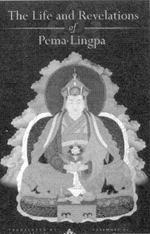For Sarah Harding, a translator of Vajrayana texts and longtime Buddhist practitioner, the invitation was irresistible: to spend a year in Bhutan preparing a book on Pema  Lingpa (1450-1521), one of Tibetan Buddhism’s five most important tertöns (treasure-revealers), and a national folk hero to the Bhutanese. Harding’s translation, The Life and Revelations of Pema Lingpa(Snow Lion, 2003; $14.95 paper), is the first to make Pema Lingpa’s terma, or treasures, available in English. The texts—taken from Lama Jewel Ocean (Lama Norbu Gyatso), one of the most important cycles in Pema Lingpa’s twenty-one-volume treasure collection—contain fundamental instructions from Padmasambhava, the eighth-century scholar who brought Buddhism to the Himalayan region and is revered as their highest teacher, Guru Rinpoche.
Lingpa (1450-1521), one of Tibetan Buddhism’s five most important tertöns (treasure-revealers), and a national folk hero to the Bhutanese. Harding’s translation, The Life and Revelations of Pema Lingpa(Snow Lion, 2003; $14.95 paper), is the first to make Pema Lingpa’s terma, or treasures, available in English. The texts—taken from Lama Jewel Ocean (Lama Norbu Gyatso), one of the most important cycles in Pema Lingpa’s twenty-one-volume treasure collection—contain fundamental instructions from Padmasambhava, the eighth-century scholar who brought Buddhism to the Himalayan region and is revered as their highest teacher, Guru Rinpoche.
Gangteng Tulku Rinpoche—one of three emanations of Pema Lingpa, and the organizer of the translation project—arranged for Harding’s stay in Bhutan, with the king’s approval. Translating the treasure texts is a priority for the country’s leaders, both to disseminate the teachings and to set the record straight. A recent scholarly work questioning Pema Lingpa’s authenticity caused a stir in this tiny mountain kingdom, now the only independent country where Tibetan Buddism is the official state religion. The Life and Revelations of Pema Lingpa includes texts tracing Pema Lingpa’s incarnations and his authentication as a “predetermined emissary” of Padmasambhava.
For Harding, a professor of Buddhist Studies at Naropa University in Boulder, Colorado, and her daughter and son—then fourteen and eleven—their year in Bhutan (1996-1997) was a singular adventure. When she wasn’t busy translating, Harding tootled around the mountain roads in a tiny Indian Maruti car, visiting cliffs, lakes, and other sacred sites where Pema Lingpa is said to have found treasures, and immersing herself in the Buddhist culture. 
To many readers, the most fascinating—and surprising—revelations in theLife and Revelations of Pema Lingpa will be Padmasambhava’s observations on women and spiritual practice. Tricycle’s Joan Duncan Oliver spoke with Sarah Harding about these treasure teachings, and her experience of Buddhism in modern-day Bhutan.
How did these treasure teachings come about? The tradition of hiding treasures, or terma—teachings to be found in later generations by a tertön, or treasure-revealer—is said to have begun with Padmasambhava in the eighth century. Padmasambhava gave teachings that were written down by his spiritual partner, Yeshe Tsogyal, then hidden in various places. Some were earth treasures, sa ter, hidden in physical places – in cliffsides, or in water, perhaps. Others were gong ter—mind treasures—that were hidden in the mind continuum of Padmasambhava’s disciples, to be discovered in their own minds in future incarnations. Pema Lingpa’s terma were earth treasures.
It’s surprising to see from Padmasambhava’s dialogues with the Bhutanese princesses how involved he was with their situation as women. Basically he’s emphasizing independence, although at first he seems to be agreeing with their own low self-esteem and self-assessment that it’s impossible for them to practice. A lot of that thinking—that they’re too stupid to practice, or not lucky enough—is internalized oppression from the culture. These women are princesses in the court, they have every advantage, but that’s not enough to give them confidence in the dharma. Guru Rinpoche seems to agree with them, and to continue their litany, “Yeah, husbands are a problem; they beat you,” and so on. His recommendation is to leave the situation altogether and go off and study dharma. Going for refuge originally meant “Come forth, leave the householder life.” These days, we have a belief that practicing the householder life is the Vajrayana way. But if the householder way is not conducive to practicing dharma, Guru Rinpoche advises leaving. In these texts, he’s giving radical alternative-lifestyle suggestions to women.
Why is English translation of the treasures so important to the Bhutanese? It gives the Bhutanese people the ability to study the dharma. The problem in modern Bhutan is that the people speak Dzongka and learn English in school, but the scriptures are in Tibetan. Monks get educated in the monasteries, where they learn Tibetan but no English, so there’s no way for them to communicate the dharma.
Strangely enough, I was asked to teach a dharma class in Bhutan, because I knew both Tibetan and English. The last thing I expected was to go to Bhutan and teach Buddhism. I did the history of Buddhism, following the curriculum I used at Naropa University Extension. The Bhutanese very much enjoyed exploring the teachings, and they weren’t afraid to ask questions of me, because I’m not a monk and didn’t expect any formalities. They’re great practitioners. They were doing ngondro—preliminary practices. The class was a really fun weekly event. We’d have a potluck afterward.
What was most moving to you about doing this translation? Living in Bhutan and being part of the spiritual cycles of life: the festivals, the rituals, the monastic activities, the pilgrimages to holy sites—all the ways the historical religion is incorporated into the rhythm of living. Every breath the Bhutanese take is the dharma. They have their yearly ceremonies, but the dharma is all they do. It’s just life. Entertainment means going to a drama about Pema Lingpa, or watching lama dances.
Is that something we can learn from them? On an individual basis. If the dharma isn’t part of your whole life, then it just becomes “going to church on Sunday.” One of the really good effects of doing a three-year retreat, which I did years ago, is that after a while you give up trying to hold out practice as something separate. You figure out, “I’m just doing life here.”
From The Life and Revelations of Pema Lingpa
When Orgyen Padmasambhava was dwelling at Samye Chimphu, Princess Tsomo and twenty-one ladies requested instruction from him. Among them was a girl, pleasing and beautiful to behold, more like a child of the gods than of humans, Princess Trompa Gyen. She took her mother’s jeweled goblet with lotus designs, filled it with grape wine, and offered it to Orgyen, saying:
Alas, Orgyen Rinpoche! In general, all women, but especially myself, have accumulated bad karma in previous lives and have taken the form of a woman….
Our minds seek virtue in the dharma,
But girls are not free to follow it.
Rather than risk a lawsuit,
We stay with even bad spouses.
Avoiding bad reputations,
We are stuck in the swamp of cyclic existence….
In youth we forget the divine dharma
And make bad karma while housekeeping.
In old age we remember the divine dharma,
But our powers have deteriorated….
Distracted by worldly activities,
We have no chance to meet a lama.
If we do stay with a lama,
His wife comes yelling….
Next time let me obtain a male body
And become independent,
that I can exert myself in the dharma
And obtain the fruit of buddhahood….
So I can escape the suffering of afflictive emotion,
Rescue me from the swamp of cyclic existence!…
[Padmasambhava] considered this and thought, “This girl is not beset by doubts or a divided mind. She has given rise to heartfelt remorse over cyclic existence. She seems to have a sincere yearning to practice dharma. If I do not teach her a dharma that will affect her deeply, remorse about cyclic existence will not continue to arise and the dharma will not stay in her mind.” Thinking this, [he] answered her with this song:
A girl should value her own worth.
Stand up for yourself, Trompa Gyen!…
If weariness with this cyclic existence has arisen
And you want to pursue the dharma now
In order to purify the obscurations of previous actions
And accomplish buddhahood later,
Turn your back on mundane cyclic existence
And make death and impermanence your inspiration.
Without needing anything, just thinking of this,
Devote yourself to dharmic pursuits.
To the lama who teaches you the Secret Mantra,
Offer the mandala of whatever comes your way.
With faithful devotion in thought, word, and deed,
Seek the presence of an authentic lama
And request the profound esoteric instructions.
Then, in a place with no conditions for delusion,
Such as a rock cave in an isolated mountain retreat,
Practice those profound instructions
And resolve them in your own mind.
From The Life and Revelations of Pema Lingpa, © 2003 by Sarah Harding. Reprinted with permission of Snow Lion Publications, Inc. www.snowlionpub.com.